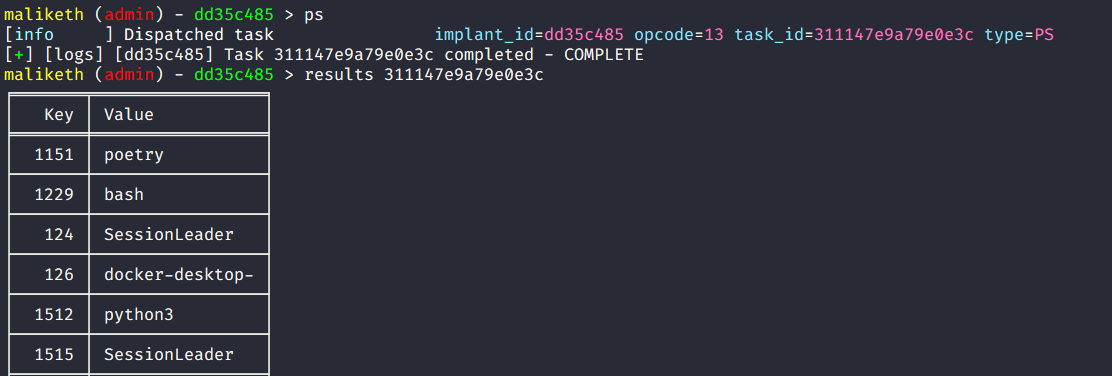The Maliketh Client
The Maliketh Operator Client is a console-based application that enables you to easily interact with implants. It is written in Python and is cross-platform.
Table of contents
Starting the client
After installing the client, starting the client is simple:
$ poetry run maliketh_client -c your_config.json
There are a few other optional command line arguments that you can use:
$ poetry run maliketh_client -h
Usage: usage: maliketh_client --config OPERATOR_CONFIG_FILE [options]
Maliketh Operator Client
Options:
-h, --help show this help message and exit
-c CONFIG, --config=CONFIG
The operator configuration file to use
-d, --debug Enable debug mode
-t, --with-timestamps
Enable timestamps in log messages
Interacting with implants
When an implant connects to the server, it will be displayed in the client. You can interact with the implant with the interact command. This will open a new shell in “interact” mode that will be used to interact with the implant. In this case, our implant’s ID is dd35c485.

Executing tasks
Once you are interacting with an implant, can execute tasks (or commands) on the implant. For example, you can execute whoami:

Retrieving output
Notice above how the output of the command is not displayed immediately. This is because the output (could) be a large amount of data. The output is stored in the database and can be retrieved with the results command, followed by the ID of the task:

More complex output
Sometimes the output of a task is more complex than just a string. For example, the output of the ps command is a map of process IDs to process names. The client will automatically detect this and display the output in a more readable tabular format:

Broadcasting commands
You can broadcast commands to all connected implants with the broadcast command. This can be useful for tasks like downloading a file from all connected implants:

Building implants
Each operator has the ability to compile new implants with some custom options. This is done with the build command. The build command will create a new implant with the given options and write it to the given output file. The output file can then be distributed to targets.
Setting build options
The following options can be set when building an implant (using the builder set command):
| Option | Arg(s) | Description |
|---|---|---|
initial_sleep_seconds | <seconds> | Set the initial sleep time |
kill_parent | <true|false> | Set the kill_parent option |
register_max_retries | <number> | Set the max number of retries for registering |
scheduled_task_name | <name> | Set the scheduled task name |
schtask_persist | <true|false> | Set the schtask_persist option |
use_antidebug | <true|false> | Set the use_antidebug option |
use_antivm | <true|false> | Set the use_antivm option |
To show the current value of a given option, use the builder show command:

Actually building the thing
Once you have set the options you want, you can build the implant with the build command, along with a path to write the file to:

Command reference
help
| Command | Subcommands | Args | Description |
|---|---|---|---|
| alias | delete, list, set | <implant_id> [alias] | Set an alias for a given implant |
| broadcast | <command> | Send an interact command to every connected implant (this can get very noisy, USE WITH CAUTION!) | |
| build | <output_file> | Build an implant with the given options and write it to | |
| builder | set, show | <option> [value] | Set or show builder options |
| exit | Exit the client | ||
| help | Show this help message and exit | ||
| interact | <implant_id> | Interact with a given implant id | |
| results | <task_id> [local_path] | Show the results of a given task id. Optionally write the results to a file | |
| show | implants, stats, tasks | Show implants, stats, or tasks |
interact
| Command | Subcommands | Args | Description |
|---|---|---|---|
| back | Exit the interact menu | ||
| chdir | <path> | Change the implant’s working directory | |
| cmd | <args> | Execute a shell command on the implant | |
| config | set, show | <option> [value] | Set or show implant configuration options |
| disable_defender | Try to disable Windows Defender (will not work if user is not admin) | ||
| download | <remote_path> | Download a file from the implant | |
| exit | Exit the interact menu | ||
| getenv | Get all environment variables | ||
| inject | <shellcode_path> <process_name> | Spawn a process then inject shellcode into it | |
| ls | List files in the implant’s working directory | ||
| ps | List running processes | ||
| pwd | Get the implant’s working directory | ||
| results | <task_id> [local_path] | Show the results of a given task id. Optionally write the results to a file | |
| selfdestruct | Remove and kill the implant | ||
| sleep | <seconds> | Sleep for a given number of seconds | |
| sysinfo | Get system information from the implant | ||
| upload | <local_path> <remote_path> | Upload a file to the implant and store it in | |
| whoami | Get the current user |